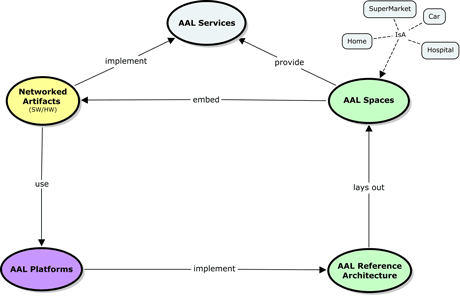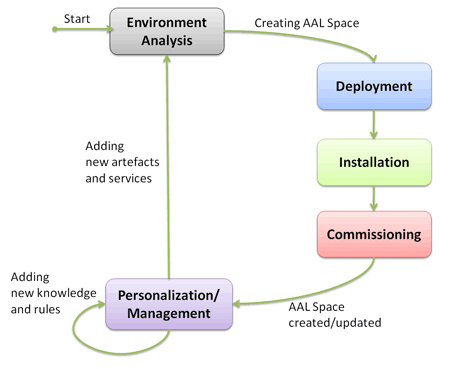by Francesco Furfari, Mohammad-Reza Tazari and Vadim Eisemberg
universAAL is a European research project that aims at creating an open platform and standards which will make it technically feasible and economically viable to develop Ambient Assisted Living solutions. The project follows an open source license model and preliminary results are already available.
universAAL is a large research project funded by the EU FP7 program. It started in February 2010 and will run for four years. universAAL aims to reduce barriers to adoption and promote the development and widespread uptake of innovative AAL solutions. It will benefit end-users (ie elderly people and people with disabilities and their caregivers and family members) by making new solutions affordable and simple to configure, personalize and deploy. It will benefit solution providers by making it easier and cheaper to create innovative AAL services or adapt existing ones. The primary users of universAAL outcomes are software developers whose business is to create AAL services. The project will provide them with a platform offering a standardized approach to develop such services and resources to make this easier.
A variety of other projects have been funded in this area in recent years, including PERSONA, MPOWER, SOPRANO, and OASIS. In order to achieve a high acceptance of the emerging open AAL platform, universAAL will consolidate the earlier work by adopting and integrating earlier results where possible and making new developments where needed.

Figure 1: The root concept map of the universAAL reference model.
An early result of the analysis and consolidation of different input projects is the universAAL reference model. The model specifies the project’s view on the core set of domain concepts and the essential interrelationships among them. The reference model is described as a set of conceptual maps and the Root Concept Map – see Figure 1 – presents the consolidated understanding of AAL systems in a single picture using the fewest possible set of concepts. AAL systems are all about the provision of AAL Services. The importance of ambient technologies in the provision of such services is highlighted by putting the concept of AAL Spaces (aka Smart Environments) and the underlying technologies (Networked Artefacts) right in this top level map. The AAL Reference Architecture and the compliant AAL Platforms incorporate the engineering challenges beyond single technologies towards modular and interoperable infrastructures. The AAL Reference Architecture identifies the basic building blocks necessary for constructing an AAL Space, such as Home, Supermarkets, Cars or Hospitals. This facilitates the provision of AAL Services with the help of embedded Networked Artefacts that implement (or contribute to the implementation of) those AAL Services. The cooperation between Networked Artefacts distributed in an AAL Space is facilitated by an AAL Platform that implements the previously mentioned reference architecture in order to provide for resource sharing, context-awareness, and personalization.
AAL space are smart environments centred on human users. The devices embedded in such environments operate collectively using information and intelligence that is distributed in the infrastructure connecting the devices. AAL Spaces are classified in space profiles, each identifying the typical set of devices used in a specific AAL scenario; we distinguish between private space profiles, like homes, versus public space profiles, like supermarkets. Space profiles include industrial standards used by devices that currently populate market segments like e-healthcare, home and building automation (eg ISO/IEEE 11073 standards, IEEE 802.15 standards). The definition of space profiles makes it economically viable to develop heterogeneous products that are still interoperable, thus paving the way to the creation of a promising AAL ecosystem.

Figure 2: The AAL Space Design process.
Another important aspect of AAL spaces is that they may be remotely managed. This is a typical requirement derived from use cases where a person is assisted by formal and informal caregivers (relatives, neighbors, and friends). Remote access and management of AAL space can be provided only after a design process that involves various professionals. The idea of standardizing the AAL space design according to a specific profile and following a well-defined process – as shown in Figure 2 - is essential to enable the seamless assistance needed by people traversing different environments. In particular, the commissioning of a system is related to the binding of those distributed services that cooperatively guarantee the basic common services characterising every AAL space (eg context information provision, user adaptation). In this way, end-users will experience an integrated world, easy to interact with, and based on natural communication where the complexity of the environment is mitigated and hidden by different ICT solutions (platforms) implementing a shared AAL reference architecture.
Details of the universAAL reference model are already available in public deliverables, which will be issued in multiple versions, as ideas and results in the project mature. The universAAL project is actively supporting the AALOA community (www.aaloa.org) and software results will be available as open source projects incubated by the AALOA organization.
Link: http://www.universaal.org
Please contact:
Joe Gorman
UniversAAL project leader
SINTEF, Norway
E-mail:










